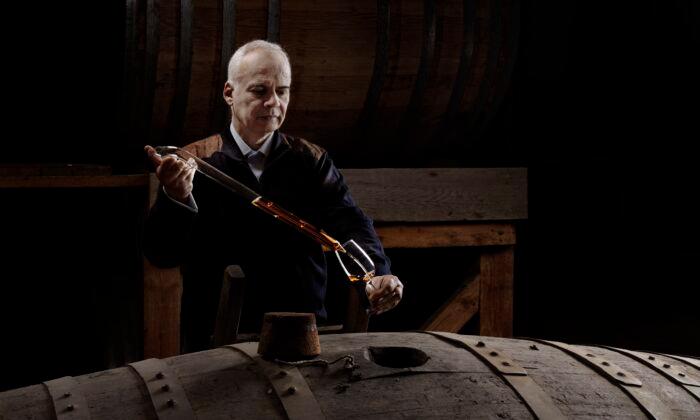In late spring on the Greek island of Samos, the gnarly vines claw their way out of the sun-scorched, stony soil on Mount Ambelos. Their branches, twisted, low-lying, and braced against sea-salt winds, hold up precious clusters of small, gold-green muscat grapes that have made this tiny isle in the North Aegean—just 27 miles long and 8 miles wide—a world-famous wine producer. Floral, honeyed, and with a delicious perfume, they are used to make some of the finest dessert wines in the world, but the best of them become a key ingredient in one of Greece’s most celebrated products: Metaxa.
I remember Metaxa from my childhood, when my parents—never big drinkers—would produce the same dusty bottle from the back of the cupboard whenever they had guests. Every Greek household had one, even if the occupants were, like my family, Cypriot. It’s a fact that Cypriots are Greek when it suits them, and Cypriot when it doesn’t! In the matter of Metaxa—a drink to be proud of—my parents were definitely Greek.

A Class of Its Own
Likened to cognac and brandy, Metaxa is actually neither, but rather a blend of wine distillates, rose petals, Mediterranean herbs, and, crucially, muscat. It was created more than 130 years ago by a silk merchant named Spyros Metaxa who dreamed of creating a new spirit that would be as smooth and luxurious as the fabric that had given his family its name and its livelihood—metaxi, or silk. Trial followed error, followed trial, followed error; yet, despite his best efforts, far from seducing the palate as he had intended, it stripped it bare. No amount of sugar could soften the drinks he produced.Finally, in 1888, Metaxa tried something different: He added aromatic muscat to sweeten his bouquet-infused Savatiano and Black Corinth wine distillates. Suddenly, he had it—he had the silken spirit he had been striving to make for years. Metaxa had arrived.
First sold as cognac, and then, after the French secured AOC status for the region in 1936, as brandy—until the category was redefined in 1987 to exclude all spirits that contained anything other than wine distillates—Metaxa now sits in a class of its own. Nothing else is made in the same way, or tastes as it does. It is now marketed simply as the amber spirit.
The original Metaxa distillery was in Piraeus, but in 1968, all production was moved to the House of Metaxa on the outskirts of Athens. This is where I met Constantinos Raptis, who has been Metaxa Master since 1992—making him the longest-serving Master—and has created some of the most remarkable styles in the spirit’s history, including Metaxa 12 Stars, Private Reserve, Angels’ Treasure, and the precious AEN series—three limited releases drawn from elixirs made from 200 blends that had been aged in the distillery’s oldest casks.
Raptis, a qualified chemist who has an additional degree in oenology, is part master blender, part distiller, and wholly Metaxa magician. He’s also a master of discretion: Apparently, only two people know what goes into the secret bouquet of herbs that makes Metaxa what it is, and he has no intention of adding a third.
“It is not necessary to reveal this information,” he responded when I asked him at least to tell me how many botanicals are used. “The only ingredient we speak about is the May rose petals, and then only because the scent is so distinctive that we cannot conceal it.” He speaks only in general terms about how Metaxa is made: The wine distillates are aged in French Limousin oak casks, blended with the best muscat, and then mixed with the secret Metaxa bouquet.

Taste Test
I followed Raptis into the cellars, walking past vast cobweb-covered casts until we reached four barrels bearing the names of the founder and his family: Spyros; his wife, Despina; and his brothers, Elias and Alexandros.“These are our oldest barrels,” he said. “They are from the early days of Metaxa, from the Piraeus distillery, and they are filled with blends that have been maturing for decades.”
Then came the chance to taste some of the varieties. I started with the Star collection, where the number of stars indicates how long the distillates have been aged. I sipped a 5 Star, a flowery blend full of jasmine and violets; progressed to the fruitier 7 Star, and then the 12, a Raptis creation. This is candied, rich—there is dark chocolate in there, honeyed figs, and dried orange. It’s as sumptuous and soft as velvet.
Passing the Torch
Many months later, I caught up with Raptis, this time in London, where he came to launch his latest release: AEN Three Generations, which will be his last AEN. It follows the first AEN, released in 2008 to mark Metaxa’s 120th birthday, and the second, 10 years later, for the 130th anniversary.AEN Three Generations one contains blends from 1910, 1920, 1960, and 1980—blends made by Elias Metaxa, his father, and his grandfather. It is a continuation, the ultimate expression of accumulated skill, dedication, and interpretation. Only 1,000 bottles have been released, and, like the previous AEN editions, are destined for dedicated collectors.
“When you taste it, you will see that the notes are in total harmony—like an orchestra,” said Raptis. “There is the warmth of honeysuckle, bergamot, nutmeg. There is the richness of blackberry, plum, and fig. There is the sweetness of wild honey, of chocolate and toffee. Give it your time. Enjoy it. Savor it; each sip reveals a new taste.”

Though he will be at Metaxa for a good while yet, there is a new Master waiting in the wings: Konstantinos Kalpaxidis is currently training under Raptis, and will take over once his tuition is complete, in perhaps two years’ time.
“Metaxa is about legacy, and heritage and tradition, not only of its founding family, but also of Greece,” said Raptis. “It was years in the making in the first instance, and it has been evolving ever since. It is infused with history. Every drop is a lesson in craftsmanship.
“Spyros passed on his art to his son, Andreas, who built on it, and then handed that down to his son, Elias, who taught me. Now the story will continue with the next Master.”
How to Serve Metaxa
While the premium varieties such as Private Reserve, Angels’ Treasure, and the remarkable AEN editions are best served as a digestif so that their elegance and complexity can best be appreciated, Metaxa’s star collection spirits are extremely versatile. Enjoy them on the rocks, served simply with lemonade or tonic water, and in classics such as Manhattans, sidecars, mojitos, and the enduring Metaxa Sour.Metaxa 12 Stars Sour
- 1 2/3 ounces Metaxa 12 Stars
- 2/3 ounce lemon juice
- 1/3 ounce sugar syrup
- Optional 2/3 ounce egg white
- 2 dashes Angostura bitters





